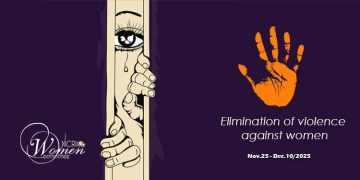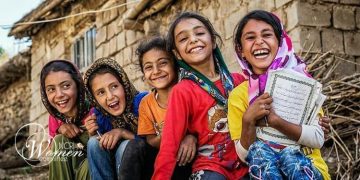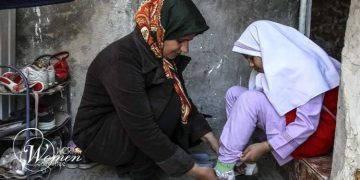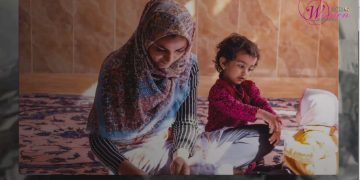Rising Unemployment and Declining Women’s Economic Participation in Iran
Women: Main Victims of Economic Crisis
Women’s economic participation in Iran is the lowest in the Middle East, after Afghanistan and Iraq. According to official regime statistics, in 2023, the economic participation rate of women in Iran was 14.4%, while in Saudi Arabia and Oman, it was more than double that of Iran.
State-run sources in Iran report that the overall unemployment rate and the unemployment rate for men decreased in the spring of 2024 compared to the previous year, while the unemployment rate for women increased during the same period. (State-run ecoiran.com – July 21, 2024)
In the spring of 2024, the working-age population in Iran was estimated to be over 65 million people, equally divided between men and women. Of the active workforce, which was calculated to be about 27 million, more than 22 million were men, 3 million were women, and 2 million were unemployed. Among the 2 million unemployed, nearly 70% were men and 30% were women.
The male participation rate was about five times that of women. The unemployment rate for women was 2.5 times that of men, indicating a deep gender gap in the labor market. Iran’s global gender gap ranking is 143, reflecting the low levels of women’s political and economic participation in the country. In recent years, this gender gap has widened due to legal and regulatory structures that make employing women more costly for employers, leading to indifference from employers towards women and girls of working age. (State-run site eghtesadnews.com – July 24, 2024)

Understanding Key Economic Terms
To get a better picture of unemployment rates and the labor market situation, it’s essential to understand a few definitions:
Active Population: The total number of employed and unemployed individuals in a society.
Economic Participation Rate: The ratio of the active population to the working-age population.
Unemployed: Individuals within the active population who are seeking employment but have not found a job.
Unemployment Rate: The ratio of unemployed individuals to the active population.
Unemployment is a significant economic indicator. A high unemployment rate indicates underutilization of the country’s labor market capacities. A reduction in the unemployment rate can have two implications: an improvement in job creation and labor market conditions, which presents a positive economic outlook, or a discouragement among the workforce leading them to leave the active population.
Besides the unemployment rate, it is crucial to also consider the economic participation rate for a better analysis of the labor market. If the unemployment rate decreases and the participation rate increases, it suggests an improving labor market. However, if the unemployment rate increases and the participation rate decreases, it indicates a declining labor market.
Labor Market Comparison for Women and Men Over Six Springs
In 2019, the economic participation rate exceeded 70%. However, both the overall unemployment rate and, specifically, the unemployment rate for women were significantly high. The simultaneous high unemployment and economic participation rates for women indicated that many people were seeking jobs, but the labor market could not accommodate this influx of workers.
The COVID-19 pandemic in the spring of 2020 had the most severe impact on women. Following the outbreak, more than one million women were laid off or dismissed during the pandemic. Many small businesses and retail shops, predominantly run by women, were closed. Despite a reduction in the total number of unemployed people, the proportion of unemployed women increased to about 32% of the total unemployed.
At the same time, the number of women in the labor force saw a significant decrease. This reduction was due to the closure of many childcare and eldercare facilities, forcing a substantial number of women to leave their jobs or stop job hunting to take care of household duties and sick family members. These factors led to many women exiting the active population and falling outside the definition of unemployment, which contributed to a decrease in the unemployment rate for women even as their share of the unemployed population increased.
In the spring of 2021, the unemployment rate for women increased while their economic participation rate decreased, indicating a challenging labor market for women. Evidence suggests that even after recovering from COVID-19, the labor market has not returned to its pre-pandemic state, and this has been particularly detrimental for women. Post-pandemic, the number of unemployed educated individuals decreased, but the number of unemployed educated women remained largely unchanged, highlighting the labor market’s inability to absorb educated female workers.
From the spring of 2022, the economic participation rates for both women and men showed a slight upward trend. The unemployment rate for men and the overall population declined, while the unemployment rate for women initially decreased but then increased again. (State-run site ecoinan.com – July 21, 2024)
In 2023, approximately 2.15 million people in the country were unemployed, with about 40% of them holding higher education degrees. Over 53% of these educated unemployed individuals were women. Studies show that one in three unemployed individuals is a woman, and among unemployed university graduates, one in two is a woman. (State-run www.panjere.news – July 14, 2024)
In the spring of 2024, the total number of employed individuals in Iran was 24.75 million, with 3.96 million of them being women, accounting for 16% of the workforce (State-run site ecoinan.com – July 25, 2024). As observed, 84% of the employed population in Iran are men, while only 16% are women. This disparity indicates unequal access to job opportunities in Iran, with women occupying less than a quarter of available positions.
Although the overall unemployment rate and the unemployment rate for men have reached their lowest levels in the past 20 springs, the economic participation rate remains lower than before the pandemic. Analysis shows that the economic participation rate for women is about one-fifth of the rate for men, and their unemployment rate is 2.5 times higher than that of men. This suggests that despite equal representation in the labor force, a deep gender gap persists in the labor market, and narrowing this gap does not appear to be imminent.

Rising Share of Women Among Educated Unemployed
As previously mentioned, in 2023, approximately 2.15 million people in the country were unemployed, with about 40% of them being higher education graduates. Among this educated unemployed population, more than 53% were women.
This indicates an increasing share of women among the educated unemployed in recent years. The proportion of women among the total unemployed has also shown an upward trend. (State-run site ecoinan.com – July 14, 2024)
Studies reveal that one in three unemployed individuals is a woman, and among unemployed university graduates, one in two is a woman. This suggests that the situation for educated unemployed women is worse compared to their non-university-educated counterparts.
In 2018, approximately 1.3 million higher education graduates were unemployed. During this period, the share of women among educated unemployed decreased from about 55% in 2017 to 52.7%.
In 2020, approximately 250,000 higher education graduates left the unemployed population, with around 150,000 of them being women. The primary cause was the COVID-19 pandemic, which led a significant number of individuals, particularly women, to exit the labor force. In other words, the rate of women leaving the labor market was higher than that of men, which contributed to a reduction in the share of women among the unemployed.
Additionally, the share of educated unemployed women among all educated unemployed individuals decreased to 49.6% in 2020.
Post-pandemic, while the total number of educated unemployed decreased, the number of educated unemployed women remained relatively stable, resulting in an increasing share of women among the educated unemployed.
In 2023, of the approximately 890,000 educated unemployed individuals, about 475,000 were women. Studies show that the number of unemployed educated women has remained nearly constant over the past four years, whereas the number of unemployed educated men has decreased during the same period.
This stability in the number of unemployed educated women could be attributed to two factors. First, the labor market may have improved post-lockdown, leading many individuals to re-enter the job market. Second, a significant number of women may have remained inactive post-pandemic and left the active population, falling outside the definition of “unemployed.” Given the trends in economic participation rates, the latter explanation is more likely.
Proportion of Unemployed Women
In 2017, women comprised approximately 32% of the unemployed population. In 2018, their share of the unemployed decreased by about one percentage point, largely due to a significant increase in the total number of unemployed, which rose to around 3.3 million people.
In 2019, the share of women among the unemployed increased to 31.7%.
In 2020, during the COVID-19 pandemic, the share of women among the unemployed decreased by over four percentage points, as previously discussed.
Post-pandemic, the proportion of women among the total unemployed has been rising again, reaching about 32%. Despite this increase, the number of unemployed women has significantly decreased compared to the pre-pandemic period, indicating that many women have become inactive, even though the labor market has improved from the pandemic’s peak.
Although more than half of university graduates in Iran are women, over 50% of educated unemployed individuals and one-third of the total unemployed population are women. This indicates that Iran’s labor market lacks the capacity to fully utilize its educated workforce and that jobs requiring the knowledge acquired in universities are not adequately available.
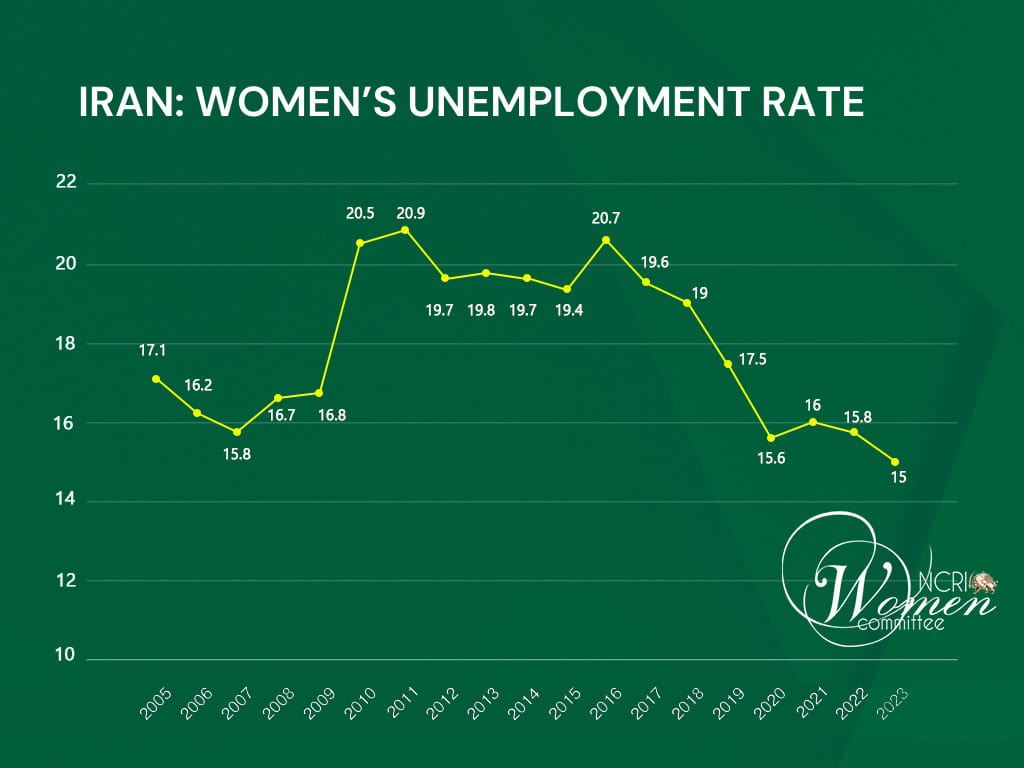
Decline in Women’s Unemployment Rate: Increased Employment or Exit from the Labor Market?
Over the past two decades, the unemployment rate for women has decreased from around 17% in 2005 to 15% in 2023. However, this decline in recent years is largely attributed to women leaving the labor market and becoming disillusioned with finding employment (State-run site Eghtesadnews.com – December 29, 2023).
Despite fluctuations, a notable aspect of this trend is the significant gap between the unemployment rates of women and men. In other words, the unemployment rate for women has been nearly twice that of men over the past two decades.
In 2023, the working-age population (aged 15 and older) in the country was about 64 million, with women making up half of this population. However, of the 26 million active workers, only about 4.5 million are women.
In 2010, the unemployment rate for women rose from 16.8% in 2009 to 20.5% and reached 20.9% in 2010. From 2010 to 2016, the unemployment rate for women remained between 19% and 20%. A downward trend began after 2016, continuing until 2019 when the rate reached 15.6%.
In 2020, the unemployment rate for women increased by 0.4 percentage points, primarily due to the COVID-19 pandemic. Since then, the rate has been on a downward trajectory.
Analyzing the unemployment rate alone can be misleading. The economic participation rate for women was above 17% in 2018 and 2019 but dropped to around 14% in the following year. In other words, many women exited the labor market after the pandemic and have not yet re-entered, contributing to the recent decline in the unemployment rate.
Nevertheless, the unemployment rate for women remains about twice that of men. This disparity indicates that women have less access to job opportunities, lower incomes, and less job security compared to men, making them more vulnerable to economic shocks.

Discriminatory Policies and Barriers to Women’s Employment in Iran
Regime policies, discriminatory and restrictive laws concerning women’s employment, and economic instability are the primary factors contributing to the low economic participation rate of women in Iran. This is despite the high number of educated women in the country.
The prevailing cultural message, propagated by the regime and specifically by the Supreme Leader, emphasizes that women’s primary roles are homemaking and childcare. Additionally, deeply ingrained misogyny within the regime’s legal framework creates numerous barriers to women’s participation in the labor market. One such legal barrier is the husband’s right to prevent his wife from working. According to Article 1117 of the Civil Code, a husband can prohibit his wife from engaging in any profession or activity that he believes conflicts with family interests or his own or his wife’s dignity.
In many countries, governments subsidize part of the costs associated with employing women to support employers during maternity leave. However, in Iran, the lack of adequate legislation means that in the private sector, pregnant women often face dismissal from their jobs, with a noticeable preference for hiring men.
The state of the country’s economy also plays a significant role in the low economic participation rate of women. For example, high inflation, economic uncertainty, and declining real wages have led many women who were previously economically active to forego employment. Due to high inflation and the failure to increase minimum wages in line with inflation, the salaries received are insufficient to meet the needs of workers. Additionally, rising costs for childcare services and nurseries have forced many Iranian women to choose between working and parenting. (State-run site Eghtesad24.com – August 5, 2024)
Moreover, recent restrictions on internet access and certain applications have led to the decline of small businesses run by women. Consequently, Iranian women must navigate various cultural, legal, and economic barriers to enter the labor market.
The findings highlighted in this report indicate that the Iranian labor market does not have the capacity to absorb the large volume of female labor and is generally designed with men in mind. Despite gender parity in education and training in Iran, women hold only a minimal share of the labor market. (State-run site Eghtesadnews.com – December 29, 2023)




